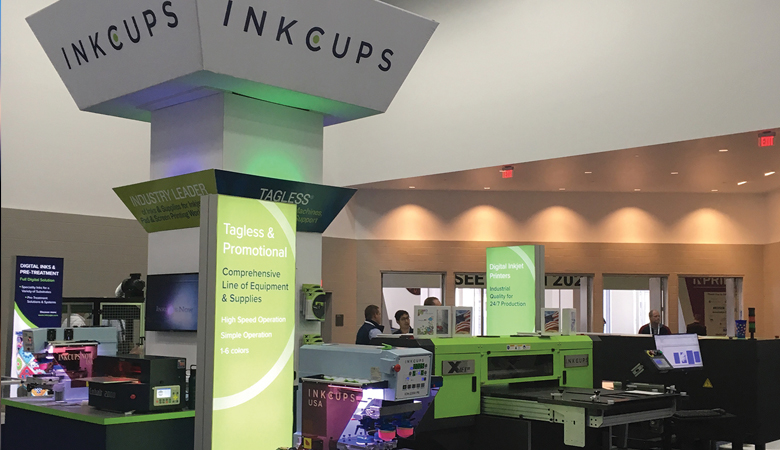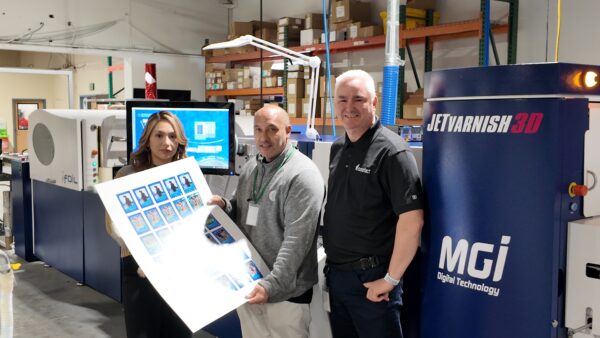Industrial Print Opportunities on Vivid Display at inPrint USA 2019
Top: Konica Minolta was one of the manufacturers familiar to readers of The Cannata Report exhibiting its industrial print solutions at inPrint USA.
If you have any kind of print background, the inPrint USA conference is quite simply fascinating. Organizers describe the conference as the only exhibition in North America solely focused on industrial printing equipment, technologies, and systems for manufacturing integration. At the show, visitors can collaborate with leading industrial print manufacturers, suppliers, service providers, and integrators to learn how the shift to inkjet and digital technology can help them target new markets and applications. Companies in multiple manufacturing and print industry sectors also come in search of competitive advantages through cost-efficient printing on all kinds of materials and shapes.
inPrint USA also offers an opportunity for attendees to build relationships, exchange ideas, and see the solutions industry peers and thought-leaders are implementing in their own businesses. At the recent exhibition in Louisville, Kentucky, April 9″“11, some of the more unusual ideas and innovation on display included edible inks, printed shoes, and inkjet robotics.
Why Industrial Print Matters
The terminology and trends on display at the conference are familiar: analog-to-digital, packaging, embellished print, labels, web and roll-to-roll, RIPs, and workflow. With so much overlap, perhaps there’s a familiar path to a greater dealer channel presence as well.
The issues that drove digital expansion in commercial print””inventory obsolescence, print-on-demand and customization””are the same forces driving industrial print.
“Industrial print is becoming super-topical to manufacturing,” said Deborah Corn of Media Centr, and an industry speaker, blogger, and host of “Podcasts From The Printerverse.”
As independent channel professionals look to the future, industrial print could offer much-needed diversification. Indeed, rapidly evolving technology is placing more systems within the reach of a wider market.
Highlights from the show floor included demonstrations of late-stage local customization, and applications involving complex shapes and challenging substrates, as well as hybrid systems for handling analog and digital workflows.
Dealer Inkjet Customization Opportunities
During her inPrint session, “Inkjet Decoration and Coating of Consumer Products and Industrial Parts,” Debbie Thorp, business development director, Global Inkjet Systems, a developer and supplier of application software, drive electronics and ink system components, noted that customizing on complex shapes creates a new set of challenges for inkjet. The print path is more complicated and involves manipulating data to wrap an image around such a surface.
Whether direct-to-shape or flatbed printing, inkjet can be digitized effectively for industrial print, according to Scott Leger, business development manager, FUJIFILM Dimatix. The usually monochrome customization focuses on small areas, perhaps for a logo, security mark, recipe, or alternative language. FUJIFILM predicts the next trend will be four-color imaging in that space.
“It seems like a big opportunity for a dealer or distributor to look at the ecosystem and represent several pieces of it,” said industry commentator Corn. “It could be one-stop shopping for people looking for this type of technology now. The machines aren’t that big, like those from Inkcups Now Corporation [a supplier and manufacturer of inkjet printing equipment, pad printing equipment, laser plate-makers, inks, and corresponding supplies]. The next frontier is in smaller industrial print companies.”
Other industry members agree.
“Some equipment is low enough””under $100K””to create opportunities for distributor arrangements,” added inkjet evangelist Craig T. Reid, founder of CTR Resources, a firm that provides consulting and independent contracted services to businesses in the digital printing space.
One-Off Integrations Challenge Managed Services
Mixed and one-off systems complicate managed services in industrial print, whether it’s a standalone digital press or a hybrid digital with 4C inkjet in a flexo process. In industrial print, it’s all about bringing systems together and achieving step-by-step color, according to Leger of FUJIFILM Dimatix. As a result, hybrid equipment configurations have become routine.
John Sillies, executive vice president, Graphic Systems Services, a manufacturer of web offset presses and inkjet web transports, explained that building a press for industrial print is so costly because so much work is one-off. Integrators could be dealing with adding industrial print workflow into a process that’s already many years old. Complications””and costs””grow when combining four-color digital printing with a traditional flexo system.
But it can be made to work. Eastman Kodak’s Rick Mazur, director, market development, packaging/labels, enterprise inkjet systems, described a client who wanted to print variable data on offset packaging for craft beer cartons. The production system was part digital, part analog.
The Supply Chain of Customization
Many consumer brands benefit from customization. When someone orders special mugs for a corporate event, for example, customization could happen at several points in the supply chain, but not all are practical. In a session devoted to customization, Chris Medrano, business development manager at Roland DGA, a manufacturer of wide-format inkjet printers and other printing equipment, identified the three levels of personalization as manufacturing, distributor, and local.
At the manufacturing level, personalization must allow for order quantity and transit time. When personalization happens at the distributor level, it’s still done weeks in advance, but instead of going all the way back to the factory, customization takes place closer to the end-consumer. This might be desirable for marketing to regional trends such as West Coast versus East Coast promotions.
Local market or late-stage customization appeals to brick-and-mortar stores and event-based needs such as weddings, reunions, and sports. Providers can customize in-store or onsite. The local personalization option avoids excess inventory and transit time. Medrano calls it “global manufacturing, local decoration.”
FUJIFILM’s Leger noted that inkjet ROI comes from the “supply chain of customization,” and the best ROI might be found with late-stage customization. For the retailer, customization represents a premium and a desirable upsell. Printers can change out logos as they become relevant for seasonal and event-driven production for things like bowl games.
Dawn Olson, industrial and production print business development manager at Konica Minolta, pointed out that local personalization allows more facetime, too, so providers can talk to customers about their next customization job.
Robots for Inkjet Accuracy
“Industrial inkjet isn’t perfect, but with software, you can correct so much,” said Global Inkjet Systems’ Thorp. The answer lies partly in manipulating the throw rate and only jetting when needed. This opens the door to another interesting twist””robots. Given the positioning accuracy of robotic arms, when the inkjet needs to be perfectly positioned, robots can repeat a step exactly each time, she said.
Thorp sees rising interest in “jet-ability” as companies seek to use inkjet in industrial applications. They must reformulate existing substrates for an inkjet printhead and digital print technology. For manufacturers who figure that out, it can mean a reduction in production cost. For specialty integrators, it could open new markets.
Managed Services in Industrial Print?
Keeping volume running through a print engine is critical, whether it’s an office MFP publishing reports or an industrial printer customizing cups.
“Once you make an investment with Konica Minolta in production or industrial print, we have a big array of marketing services,” explained Konica Minolta’s Olson. “We focus on creating volume to get you to the point of pure profit as fast as possible.”
As with any MPS engagement, an assessment can be a valued service for industrial print, and Konica Minolta brings this to the table.
“We do an analysis of the existing business and come back with a design for the whole thing,” said Olson.
Konica Minolta analyzes the workflow and uses heat-mapping to observe visits to each area. In that way, it can pinpoint opportunities to streamline and reduce cost for an industrial print facility.
Taking 3D from Prototyping to Production
Dr. Rich Baker, president, Integrity Industrial Inkjet Integration, a full service industrial inkjet integrator, educated inPrint attendees about advances in 3D manufacturing. Taking 3D from rapid prototyping to inkjet production is still largely a one-off proprietary world for now, but inkjet is inherently scalable, and Baker noted the market is getting closer to true 3D printing, rather than simply rapid prototyping. As one of the largest independent inkjet 3D system integrators in North America, Integrity Industrial Inkjet Integration does a lot with inkjet chemistry and testing.
Say Yes to Industrial Print
For the independent dealer channel, industrial print may indeed represent future opportunities. Based on our experience at inPrint, independent dealers have several ways to build a more active presence and participation in this industry, and some pockets of the channel are already making inroads, particularly with inkjet.
Inkcups, a provider and manufacturer of pad printing equipment, digital inkjet equipment, laser plate-makers, and corresponding supplies, was generating a lot of interest from visitors at its booth.
Access Related Content
Visit the www.thecannatareport.com. To become a subscriber, visit www.thecannatareport.com/register or contact cjcannata@cannatareport.com directly. Bulk subscription rates are also available.





